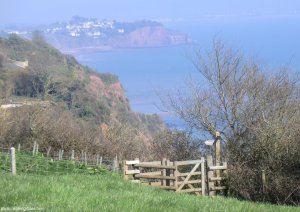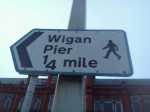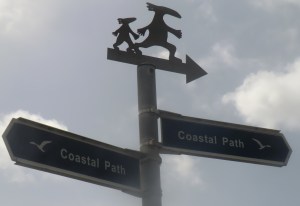When I’m at home it’s a rare day that I don’t walk down the Thames Path. True, more often than not, it’s the same stretch that takes me to and from the station or Sainsburys or my local, The Boaters Inn, or sometimes all three; rather than the Simon Armitage, 268 mile Pennine Way challenge of Walking Home. Nonetheless it makes the subject of National Trails very dear to my heart. So if I didn’t exactly experience fear when I heard the government was conducting a review of England’s National Trails it wasn’t unbridled happiness either. Regular readers will know I occupy a different space on the political spectrum but after 2 years of this coalition my default reaction to almost any government initiative is to recall some lines from Woody Guthrie’s Pretty Boy Floyd:
challenge of Walking Home. Nonetheless it makes the subject of National Trails very dear to my heart. So if I didn’t exactly experience fear when I heard the government was conducting a review of England’s National Trails it wasn’t unbridled happiness either. Regular readers will know I occupy a different space on the political spectrum but after 2 years of this coalition my default reaction to almost any government initiative is to recall some lines from Woody Guthrie’s Pretty Boy Floyd:
As through this world I’ve rambled I’ve seen lots of funny men;
Some will rob you with a six-gun and some with a fountain pen.
And if you forgive the historical anachronism not to mention the absence of rhyme I take this to include cybercrime and BlackBerry these days.
As well as thoroughly trashing the economy – who has a good word to say about Osborne now? – they keep tinkering with the environment. (And I probably don’t need to remind you what a success they made of their plan to sell off our forests.) So let me make this plain – I see the implementation of this report as it stands as a clear and present danger to the majority of walkers in England.
It is difficult to see how any of those who devised this plan have laced up boots let alone walked along any one of the thirtee n English National Trails. As Roly Smith puts it so much more eloquently than me: “I was privileged to know Tom Stephenson, the creator of our first National Trail, the Pennine Way, as a friend, and I think I know what he would have said about these new proposals to create National Trail Partnerships. ‘Ee lad,’ he’d say in that warm, Lancashire burr, ‘that’s not what I had in mind at all.’ National Trails are a national, i.e. Government, responsibility – that’s after all why they are called “National” Trails. To entrust their management, protection and promotion to these proposed new voluntary bodies ignores the fact that they are a national, indeed, international, asset in our increasingly-beleaguered countryside. The Government should live up to its responsibility and not leave their management to already hard-pressed local authorities and volunteers.”
n English National Trails. As Roly Smith puts it so much more eloquently than me: “I was privileged to know Tom Stephenson, the creator of our first National Trail, the Pennine Way, as a friend, and I think I know what he would have said about these new proposals to create National Trail Partnerships. ‘Ee lad,’ he’d say in that warm, Lancashire burr, ‘that’s not what I had in mind at all.’ National Trails are a national, i.e. Government, responsibility – that’s after all why they are called “National” Trails. To entrust their management, protection and promotion to these proposed new voluntary bodies ignores the fact that they are a national, indeed, international, asset in our increasingly-beleaguered countryside. The Government should live up to its responsibility and not leave their management to already hard-pressed local authorities and volunteers.”
And it is the ‘National’ in National Trails that is at the heart of these dangerous proposals. Natural England, who currently manage and maintain National Trails, have begun discussions to hand this power to new Local Trail Partnerships made up of local authorities, business and volunteers. The Ramblers, who played a key role in establishing the trails, is concerned that the lack of a national champion to oversee, guide and support these Local Trail partnerships will leave them vulnerable; resulting in a fragmented network with inconsistent quality between trails and cash strapped Local Authorities unable to sustain funding.
National Trails, have begun discussions to hand this power to new Local Trail Partnerships made up of local authorities, business and volunteers. The Ramblers, who played a key role in establishing the trails, is concerned that the lack of a national champion to oversee, guide and support these Local Trail partnerships will leave them vulnerable; resulting in a fragmented network with inconsistent quality between trails and cash strapped Local Authorities unable to sustain funding.
I don’t know about you but I often struggle to articulate the joy, experience and worth of walking. As a result I often fall back on a variation of the Albert Einstein quote and end up saying: ‘Not everything of value can be counted and not everything that can be counted has value.’ Strangely in the case of the National Trails we can mount a formidable case of proven value that can be counted. Lets bullet point:
- Over 2000 miles of National Trails in England
- Attract over 12 million visitors each and every year
- First (Pennine Way) developed by the Ramblers and established in 1965
- This spans 10 local authorities, 3 national Parks & 1 Area of Outstanding Natural Beauty
- The South West Coast Path generates over £300 million for local communities per year
- And supports over 7500 jobs
Or as Stuart Maconie says: “I have walked several national trails, both for recreation and as two major outside broadcasts for Radio 2 on the Jurassic Coast and Hadrian’s Wall. I’ve seen firsthand how they increase people’s enjoyment, understanding and appreciation of our countryside and how much they benefit the economy by attracting tourists from across the world. I am therefore very concerned about any moves that will affect their upkeep, access and quality. I hope Natural England will make a sensible decision with regard to this. These are precious assets hard won and we should cherish them”.
And let’s not forget these proposals also fail to incorporate plans to integrate the English Coastal Path – which will be designated a National Trail in its own right when it opens in full – this will see a doubling of the number of miles of National Trails in England.
Walkers tell me that they cherish our National Trails because they showcase much that is worth experiencing environmentally, historically and  culturally, in England. They also love the fact that they can rely on the fact that these paths will be, in the main, well maintained and signposted. We often hear exotic foreign climes exalted as once in a lifetime destinations. In my experience this is far outweighed by walkers setting aside time to walk our National Trails from start to finish and achieve a lifelong dream.
culturally, in England. They also love the fact that they can rely on the fact that these paths will be, in the main, well maintained and signposted. We often hear exotic foreign climes exalted as once in a lifetime destinations. In my experience this is far outweighed by walkers setting aside time to walk our National Trails from start to finish and achieve a lifelong dream.
The Ramblers played a pivotal role in establishing the National Trails and today is seriously concerned that government’s hastily conceived proposals could see a dramatic fall in the quality of the Trails. Paths could fall into disrepair, potentially obstructing access for the millions of people who enjoy the trails and who generate significant revenue for the local economy. They would like to see government rethink its plans and are ready to work with them to take a leading role in the future support and promotion of these national treasures.
Back in the 17th century Gerard Winstanley was expressing a much more extreme radical idea when he called for the land to be ‘a common treasury for all’ and it seems absurd that this limited, yet significant, successful application of his dream is under threat from an idiotic government that shows daily it has no concept of how normal people live and enjoy their lives. Let’s make sure that the future still sees a national body to champion our National Trails, they are after all, national treasures!
Don’t let the English National Trail network go Titanic – here’s how you can help:
- Join the Ramblers here
- Donate to the campaign here
- Sign up for campaign updates here
- Let Natural England know what you think of our National Trails here
- Contact The Ramblers to find out more about becoming a National Trail Champion here
- Share your National Trail photos with the Ramblers (here’s some of mine of the Thames Path)
Listen to:
Ramblin’ Jack Elliot – Pretty Boy Floyd
Gruff Rhys – Follow The Sunflower Trail (Theme Tune For a National Strike)
Attila The Stockbrocker – March of the Levellers – The Digger´s Song – The World Turned Upside Down













 Just a Minute
Just a Minute
